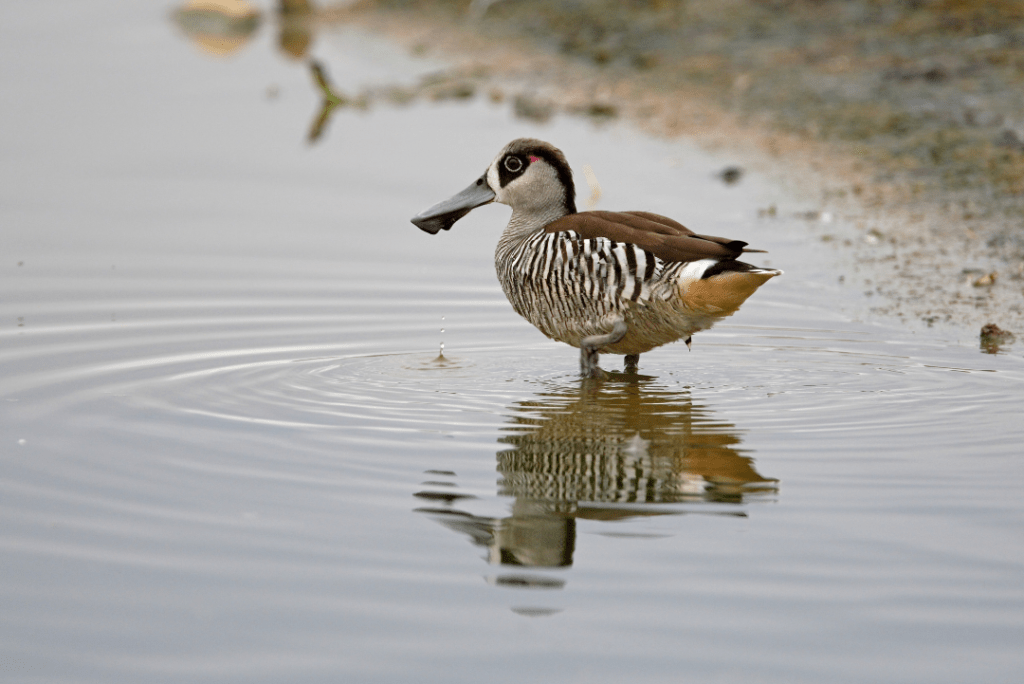In the fascinating world of birds, there’s nothing more enchanting than the sight of pink-feathered beauties gracing the skies and perching among the trees. Pink coloration, often associated with love and beauty, truly brings a touch of magic to our avian friends. In this blog, we’ll embark on a journey to discover 23 mesmerizing pink bird species from all corners of the world. So, let’s dive into the realm of these feathered wonders and learn about their habitats, sizes, life expectancies, and tips for spotting and attracting them.

Importance of Pink Coloration
The pink coloration found in birds is not just a whimsical trait; it serves a vital purpose in their lives. Ranging from attracting mates to blending into their surroundings, these rosy hues make these birds both captivating and highly adaptable.
Overview of the 23 bird species
Our journey takes us through five continents, covering North and South America, Europe, Africa, Asia, and Australia. Each region is home to a variety of bird species that boast unique features, behavior, and habitats. So, let’s start our adventure with North American pink birds.
North American Pink Birds
American Flamingo
The American Flamingo is one of the most iconic and easily recognizable pink birds in the world. They are characterized by their long legs, curved neck, and vibrant pink feathers. Flamingos get their pink coloration from the carotenoids found in their diet, which consists mainly of shrimp and algae.
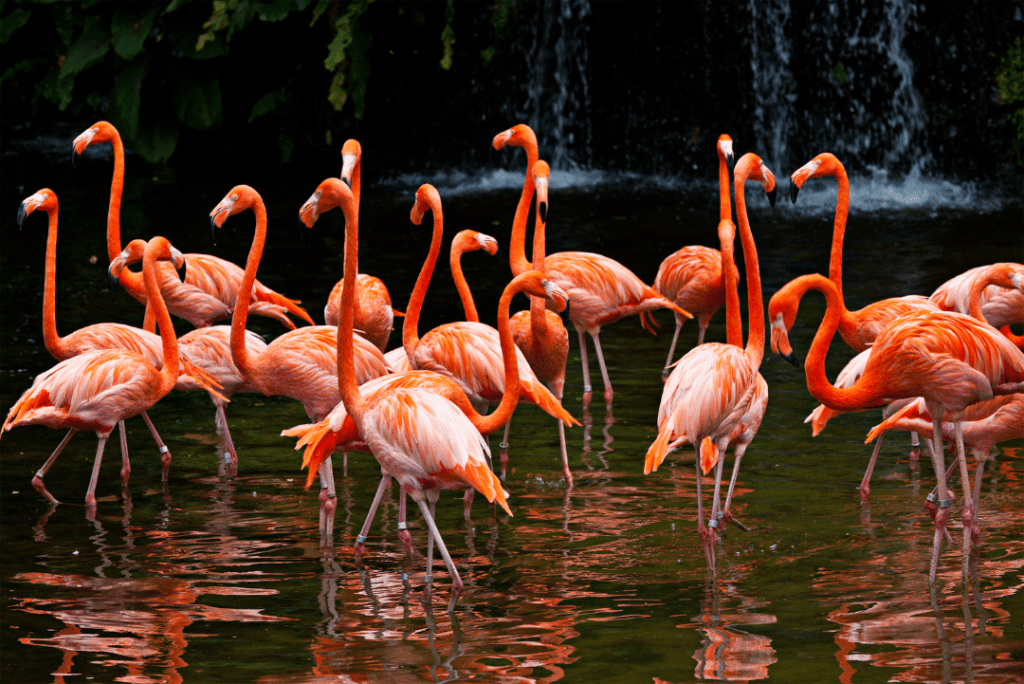
Habitat and geographic range
These elegant birds can be found in the Caribbean, parts of Central America, and along the coastlines of northern South America. In the United States, they are most commonly seen in Florida.
Size:
American Flamingos have an average length of 47 inches, a weight of around 6.2 pounds, and a wingspan of up to 60 inches.
Average life expectancy
These birds can live up to 40 years in the wild, but they often live longer in captivity.
Tips for spotting and attracting American Flamingos
Visit shallow wetlands and coastal areas to find American Flamingos. They are social birds, often found in large colonies. To attract them to your area, create a shallow water source with plenty of aquatic plants and insects for them to feed on.
Roseate Spoonbill
The Roseate Spoonbill is a unique wading bird with a long, spatula-shaped bill that it uses to sweep through shallow water to catch small fish and crustaceans. Its feathers display various shades of pink, ranging from pale to deep rosy hues.

Habitat and geographic range
Roseate Spoonbills are found in the southeastern United States, Mexico, Central America, and the Caribbean.
Size:
These birds have a length of 28-34 inches, a weight of 2.6-4.4 pounds, and a wingspan of 47-52 inches.
Average life expectancy
Roseate Spoonbills have a life expectancy of around 15 years in the wild.
Tips for spotting and attracting Roseate Spoonbills
Look for Roseate Spoonbills in shallow wetlands, mangroves, and marshes. They are more active during early morning and late afternoon. To attract them, create a shallow water source with aquatic vegetation and small fish.
Anna's Hummingbird
Anna’s Hummingbird is a small, vibrant bird with iridescent pink and green feathers. The males are particularly striking, with a bright pink throat patch known as a gorget. These agile birds are known for their incredible hovering and flying abilities.
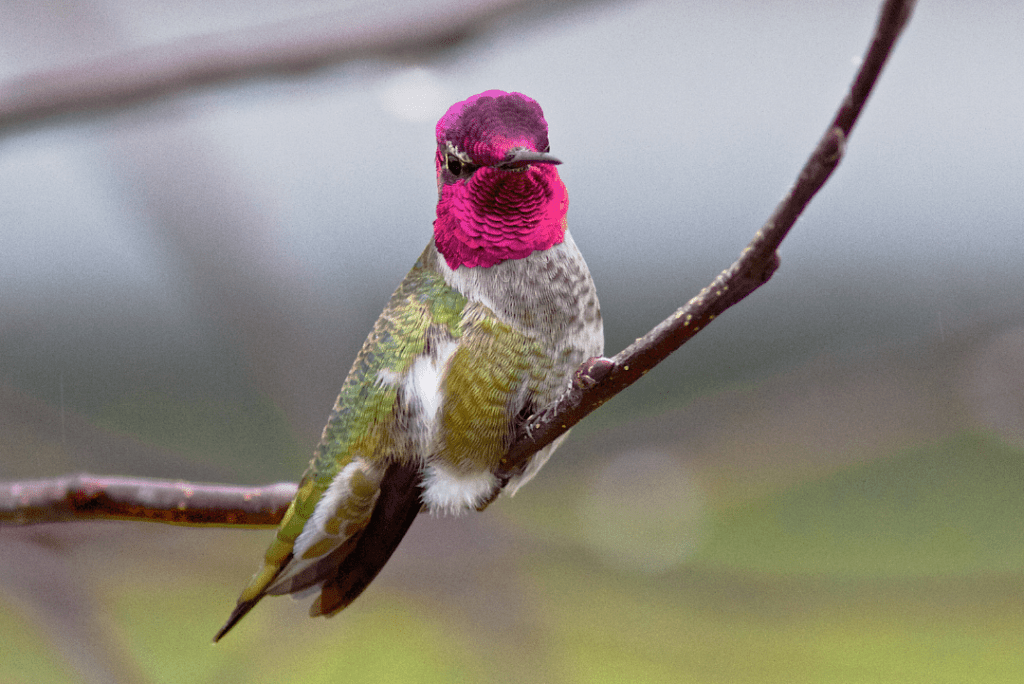
Habitat and geographic range
They are found along the western coast of North America, from Alaska to Baja California.
Size:
Anna’s Hummingbirds measure about 3.9-4.3 inches in length, weigh around 0.1-0.2 pounds, and have a wingspan of 4.7-4.9 inches.
Average life expectancy
These tiny birds have a life expectancy of 3-5 years in the wild.
Tips for spotting and attracting Anna's Hummingbirds
To spot Anna’s Hummingbirds, visit areas with abundant flowers, shrubs, and trees. You can attract them to your garden by planting nectar-rich flowers and providing hummingbird feeders filled with sugar water.
Brown-capped Rosy-Finch
The Brown-capped Rosy-Finch is a small passerine bird with a brown head and a pinkish body. The males are more vibrant in color than the females. These birds are well-adapted to living in high-altitude environments.
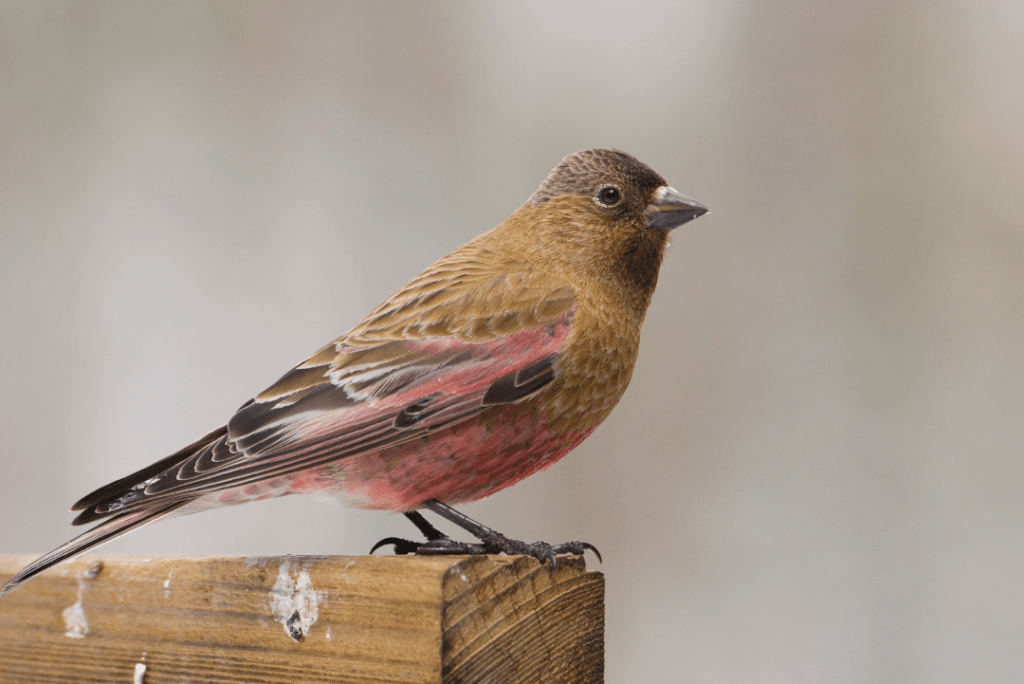
Habitat and geographic range
They are found in the alpine and subalpine regions of the central Rocky Mountains, in areas of Colorado, Wyoming, and New Mexico.
Size:
Brown-capped Rosy-Finches have a length of 5.5-6.3 inches, a weight of 0.8-1.1 ounces, and a wingspan of 13-15 inches.
Average life expectancy
These birds have a life expectancy of around 3-5 years in the wild.
Tips for spotting and attracting Brown-capped Rosy-Finchs
To spot Brown-capped Rosy-Finches, visit alpine and subalpine habitats during the summer months. You can attract them to your backyard by providing seed feeders, especially during the winter.
Black Rosy-Finch
The Black Rosy-Finch is another small passerine bird with a striking contrast between its black head and pinkish body. Like the Brown-capped Rosy-Finch, these birds are well-adapted to high-altitude environments.
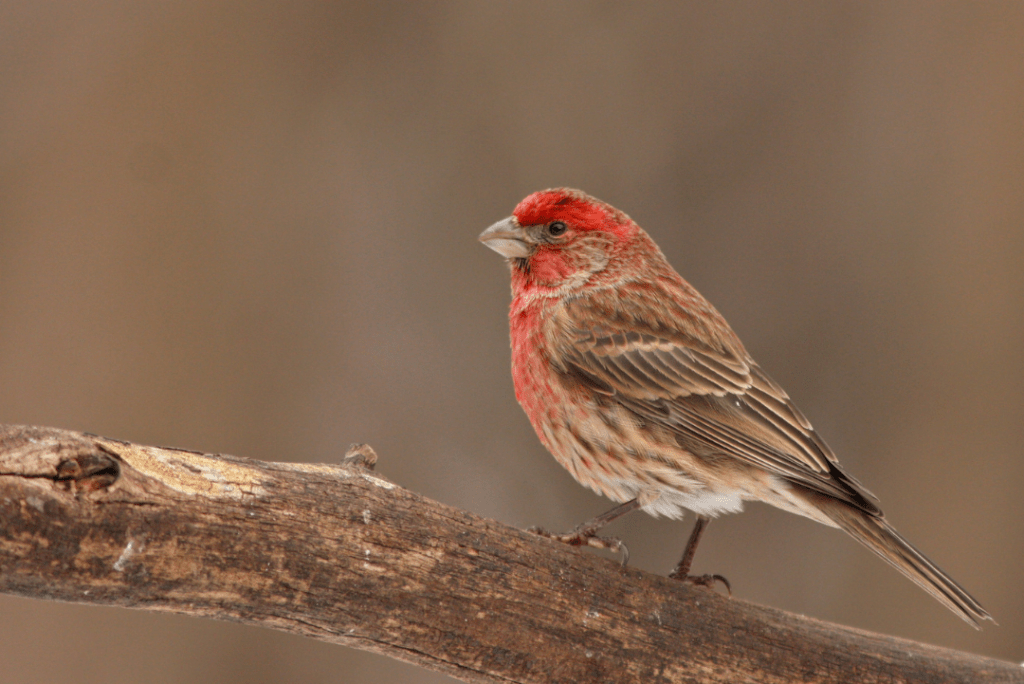
Habitat and geographic range
Black Rosy-Finches are found in the mountainous regions of the western United States, from Idaho and Montana down to New Mexico and Arizona.
Size:
These birds measure 5.5-6.3 inches in length, weigh around 0.8-1.1 ounces, and have a wingspan of 13-15 inches.
Average life expectancy
Black Rosy-Finches have a life expectancy of 3-5 years in the wild.
Tips for spotting and attracting Black Rosy-Finchs
Visit alpine and subalpine habitats during the summer months to spot Black Rosy-Finches. Attract them with seed feeders during the winter months.
Gray-crowned Rosy-Finch
The Gray-crowned Rosy-Finch is another passerine bird in the rosy-finch group. It features a gray head and a pinkish body, with males displaying more vibrant colors than females. These birds are also well-adapted to high-altitude environments.
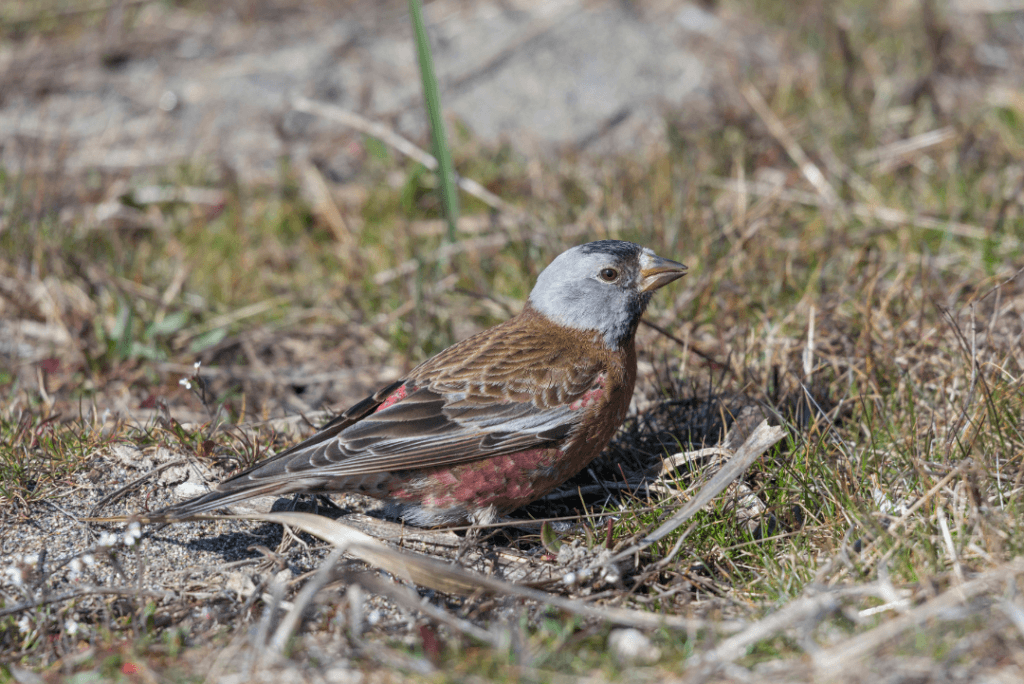
Habitat and geographic range
Gray-crowned Rosy-Finches are found in the mountainous regions of western North America, from Alaska to the Sierra Nevada in California, and parts of the Rocky Mountains.
Size:
These birds have a length of 5.5-6.3 inches, a weight of 0.8-1.1 ounces, and a wingspan of 13-15 inches.
Average life expectancy
Gray-crowned Rosy-Finches have a life expectancy of 3-5 years in the wild.
Tips for spotting and attracting Gray-crowned Rosy-Finchs
To spot Gray-crowned Rosy-Finches, visit alpine and subalpine habitats during the summer months. Attract them with seed feeders during the winter months.
White-winged Crossbill
The White-winged Crossbill is a small, unique bird with crossed mandibles, which allows it to extract seeds from conifer cones. Males have a pinkish-red plumage, while females are more yellowish-green. These birds are nomadic, often moving in search of food.
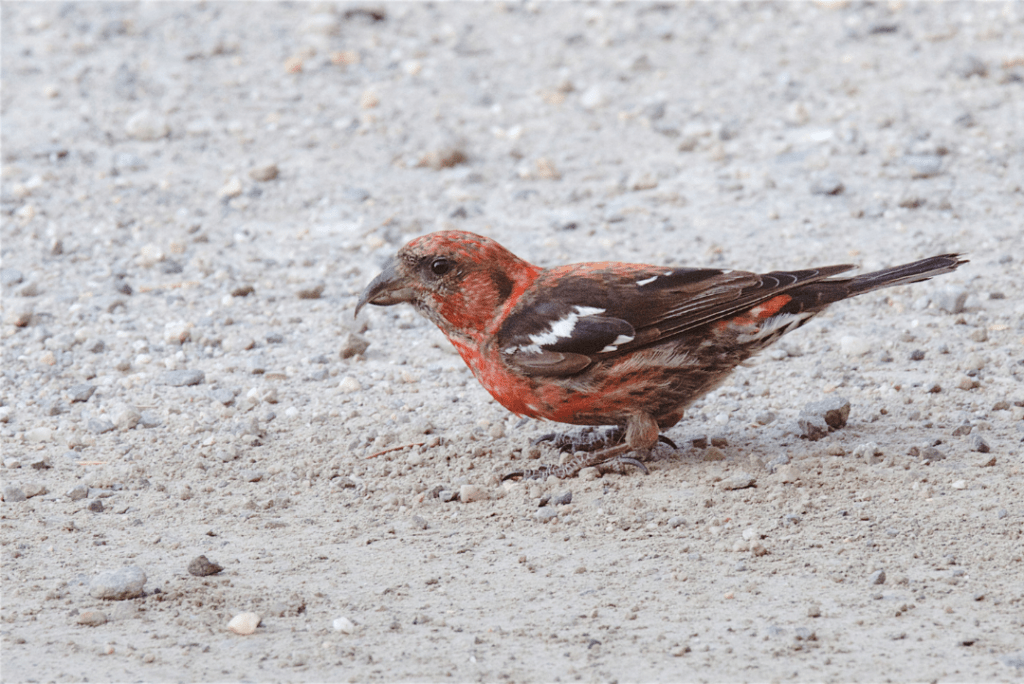
Habitat and geographic range
White-winged Crossbills are found in the coniferous forests of North America, from Alaska to Newfoundland and south to the northern United States.
Size:
These birds have a length of 6-7 inches, a weight of 0.9-1.3 ounces, and a wingspan of 10-11 inches.
Average life expectancy
White-winged Crossbills have a life expectancy of 8-10 years in the wild.
Tips for spotting and attracting White-winged Crossbills
To spot White-winged Crossbills, visit coniferous forests, especially during the winter months. Attract them with a variety of seeds, especially those from coniferous trees.
Pine Grosbeak
The Pine Grosbeak is a large, plump finch with a thick, stubby bill. Males have a rosy-pink plumage, while females are more grayish-brown. These birds are often found in flocks, feeding on seeds, buds, and fruits.
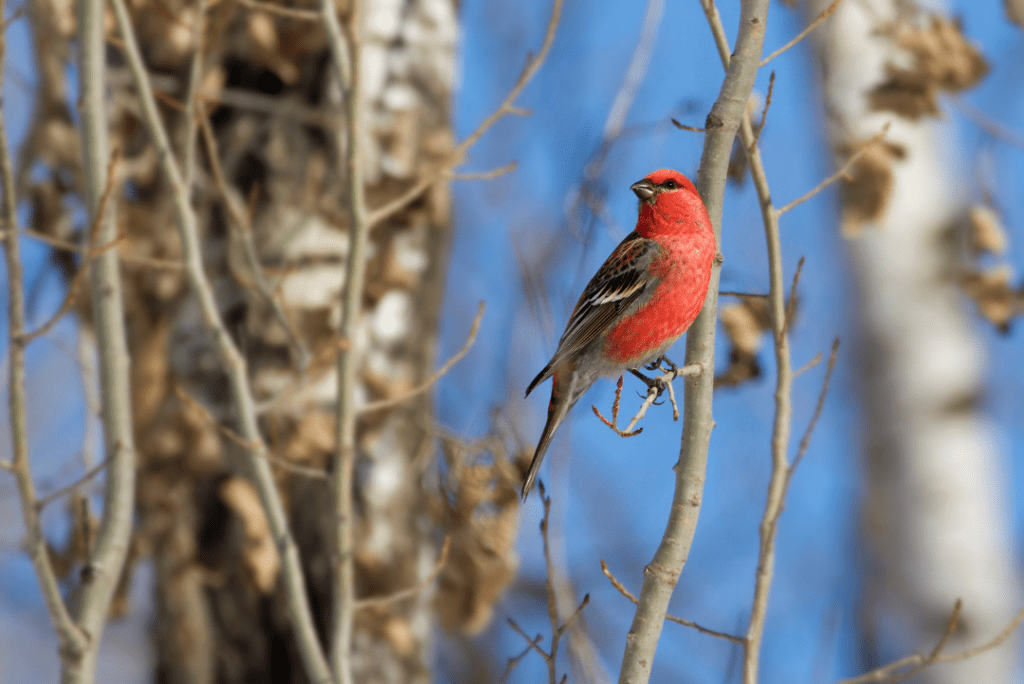
Habitat and geographic range
Pine Grosbeaks are found in the coniferous forests of North America, Europe, and Asia.
Size:
These birds have a length of 8-10 inches, a weight of 1.8-2.8 ounces, and a wingspan of 13-14 inches.
Average life expectancy
Pine Grosbeaks have a life expectancy of 9-10 years in the wild.
Tips for spotting and attracting Pine Grosbeaks
To spot Pine Grosbeaks, visit coniferous forests, especially during the winter months. Attract them with a variety of seeds, including sunflower, safflower, and nyjer seeds.
Pink-eared Duck
Habitat and geographic range
Pink-eared Ducks are native to Australia, found in a wide range of wetland habitats, including swamps, lagoons, and lakes.
Size:
These ducks have a length of 15-17 inches, a weight of 1-1.2 pounds, and a wingspan of 23-27 inches.
Average life expectancy
Pink-eared Ducks have a life expectancy of 6-8 years in the wild.
Tips for spotting and attracting Pink-eared Ducks
To spot Pink-eared Ducks, visit wetlands and water bodies in Australia. Look for them in pairs or small groups, often swimming in tight circles to create whirlpools that bring food to the surface. To attract them, provide a shallow water source with plenty of aquatic plants and insects.
South American Pink Birds
Greater Flamingo (Phoenicopterus roseus)
The Greater Flamingo is the largest and most widespread flamingo species. With their long legs, curved necks, and unmistakable pink plumage, these birds are a sight to behold. Their color comes from the pigments in the organisms they feed on, such as shrimp and algae.
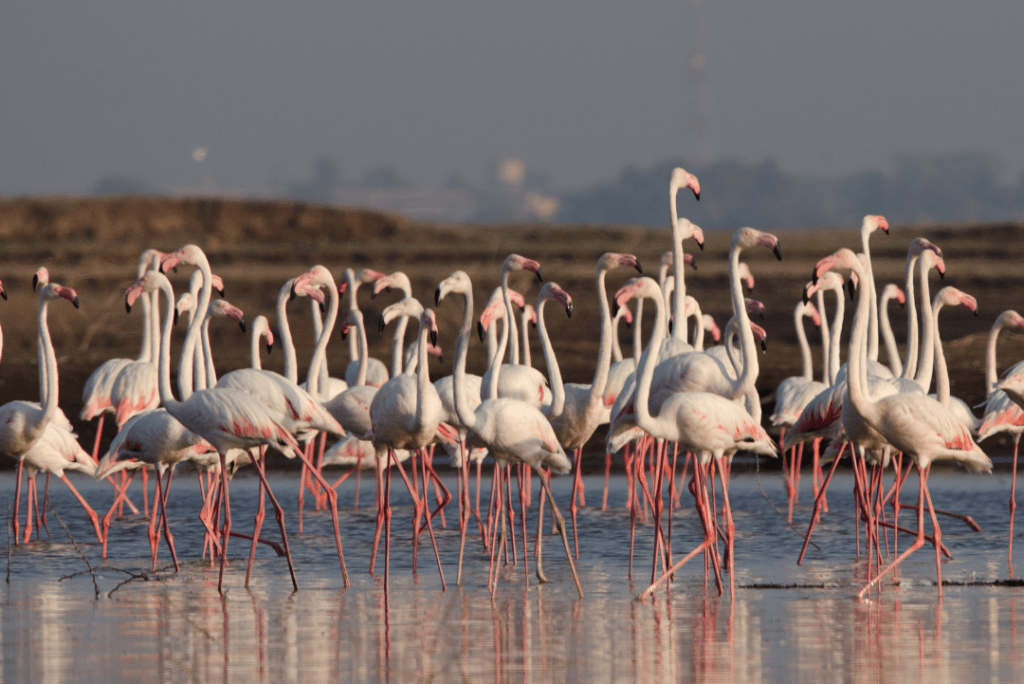
Habitat and geographic range
These birds inhabit the shallow waters of lakes, lagoons, and mudflats in parts of Africa, southern Europe, and South Asia. In South America, they can be found in the Caribbean and the Galápagos Islands.
Size:
- Length: 110-150 cm
- Weight: 2-4 kg
- Wingspan: 140-165 cm
Average life expectancy
Greater Flamingos have a life expectancy of 30-40 years in the wild.
Tips for spotting and attracting Greater Flamingos
Visit their natural habitats, like shallow lakes or lagoons, during the breeding season (from March to June). Bring binoculars or a spotting scope to observe them from a distance. Avoid getting too close, as it may disturb the birds.
Hoopoe (Upupa epops)
The Hoopoe is known for its striking appearance, with a long, curved bill, a distinctive black-and-white striped pattern on the wings and tail, and a pinkish-brown body. The most remarkable feature is the crest on the head, which can be raised when the bird is alarmed or excited.

Habitat and geographic range
Hoopoes inhabit a wide range of habitats, including grasslands, forests, and farmlands across Europe, Asia, and Africa. They are also found in parts of South America as vagrants or accidental visitors.
Size:
- Length: 25-32 cm
- Weight: 46-89 g
- Wingspan: 44-48 cm
Average life expectancy
Hoopoes have a life expectancy of 5-10 years in the wild.
Tips for spotting and attracting Hoopoes
Look for them on the ground, where they forage for insects, or perching on trees and fences. They can be attracted to gardens by providing nesting sites, such as tree cavities or nest boxes, and by maintaining a pesticide-free environment.
Pink-headed Warbler (Cardellina versicolor)
The Pink-headed Warbler is a small, striking bird with a bright pink head and chest, and a deep red body. They are known for their beautiful, warbling song, which they use to communicate and defend their territory.
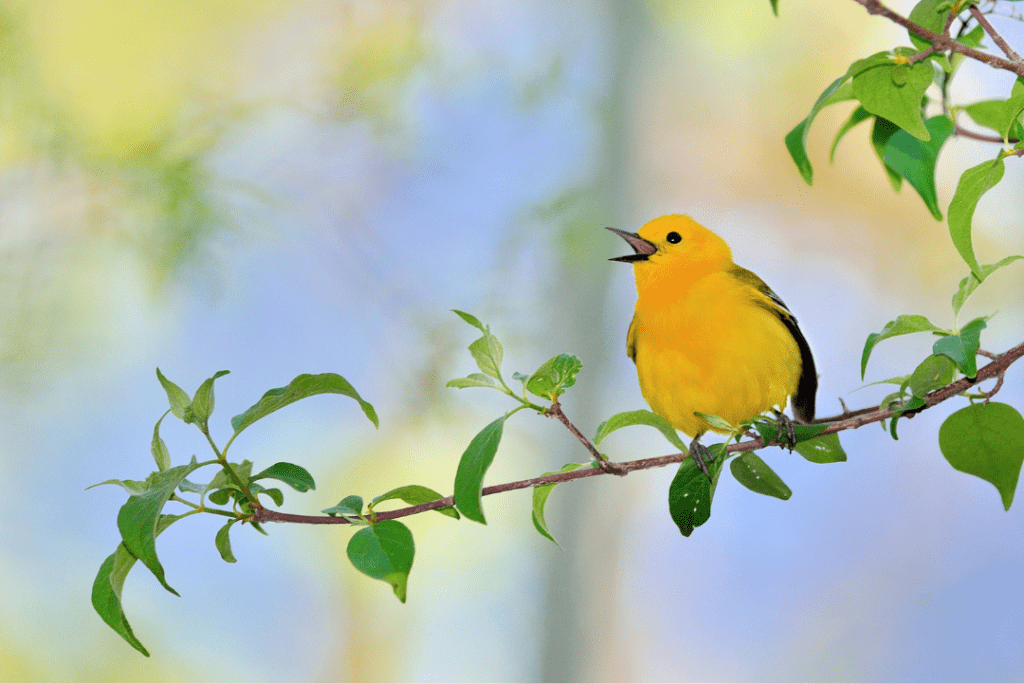
Habitat and geographic range
These birds are found in the highlands of southern Mexico and Guatemala, where they inhabit pine-oak and cloud forests.
Size:
- Length: 12-14 cm
- Weight: 8-10 g
Average life expectancy
Pink-headed Warblers have a life expectancy of 3-6 years in the wild.
Tips for spotting and attracting Pink-headed Warblers
Visit their natural habitat during the breeding season (from March to July) and listen for their songs. Use binoculars or a spotting scope to observe them as they forage in the canopy or on the ground. Be patient, as these small birds can be elusive.
European Pink Birds
Western Rosella (Platycercus icterotis)
The Western Rosella is a small, colorful parrot native to Australia, characterized by its striking red and green plumage and a bluish-pink patch on the cheeks. Males have a more vibrant coloration than females.
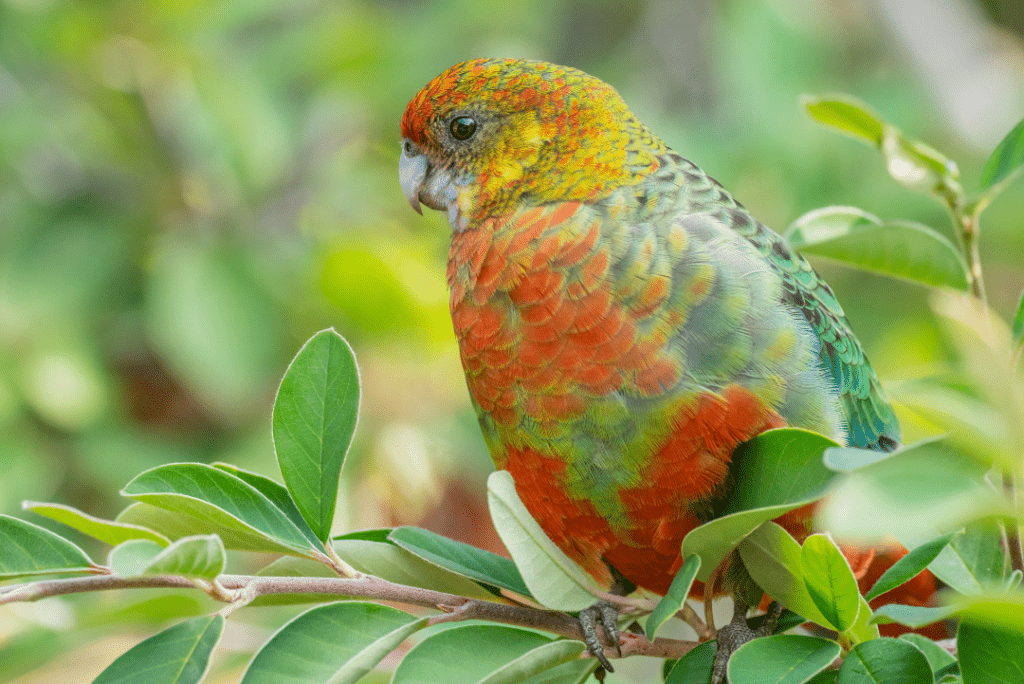
Habitat and geographic range
Found in the southwestern regions of Australia, they inhabit eucalyptus forests, woodlands, and farmlands.
Size:
- Length: 25-30 cm
- Weight: 80-120 g
Average life expectancy
Western Rosellas can live 10-15 years in the wild, up to 25 years in captivity
Tips for spotting and attracting Western Rosellas
Look for them feeding on seeds, fruit, and insects in trees and shrubs. They can be attracted to gardens by providing native plants, bird feeders with seeds, and a birdbath for drinking and bathing.
Himalayan White Browed Rosefinch (Carpodacus thura)
The Himalayan White Browed Rosefinch is a beautiful, medium-sized finch with a pinkish-red body, a white eyebrow stripe, and black markings on the wings and tail. Males have a more vibrant coloration than females.
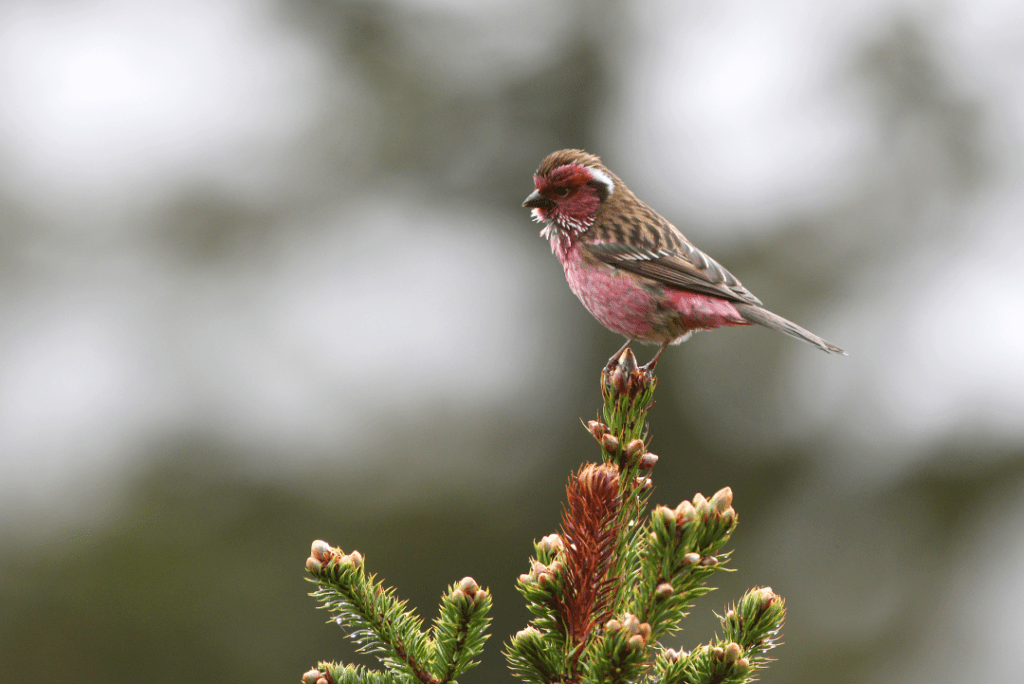
Habitat and geographic range
They are native to the Himalayas, inhabiting montane forests, shrublands, and alpine meadows in India, Nepal, Bhutan, and China.
Size:
- Length: 16-18 cm
- Weight: 25-35 g
Average life expectancy
Unknown
Tips for spotting and attracting Himalayan White Browed Rosefinch
Visit their natural habitat, such as high-altitude forests and meadows, during the breeding season (from May to September). Look for them foraging on the ground or in the trees, and listen for their distinctive songs. Be patient and use binoculars to observe them from a distance.
Asia and Australia
Major Mitchell's Cockatoo (Lophochroa leadbeateri)
The Major Mitchell’s Cockatoo, also known as the Pink Cockatoo, is a striking bird native to Australia. It is characterized by its soft pink plumage and a large, red-and-yellow crest that it raises when excited or alarmed.

Habitat and geographic range
Found in arid and semi-arid regions of Australia, they inhabit woodlands, scrublands, and farmlands.
Size:
Length: 35-40 cm,
Weight: 450-600 g
Wingspan: 80-100 cm
Average life expectancy
Major Mitchell’s Cockatoos can live up to 40-60 years.
Tips for spotting and attracting Major Mitchell's Cockatoos
Look for them feeding on seeds and fruits in trees and shrubs or foraging on the ground. They can be attracted to gardens by providing native plants, bird feeders with seeds, and a birdbath for drinking and bathing.
Rose-Breasted Cockatoo (Galah) (Eolophus roseicapilla)
The Rose-Breasted Cockatoo, also known as the Galah, is a medium-sized, charismatic parrot native to Australia. It has a rose-pink head, chest, and belly, with a silver-gray back, wings, and tail.
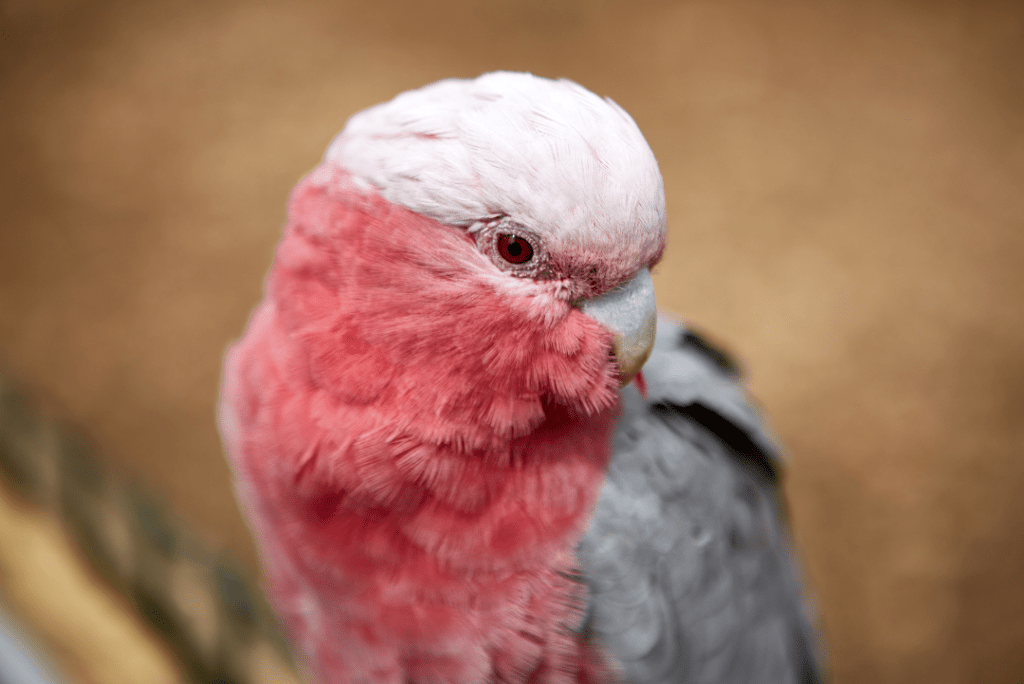
Habitat and geographic range
Found throughout Australia, they inhabit open woodlands, grasslands, and urban areas.
Size:
- Length: 35-38 cm
- Weight: 270-350 g
- Wingspan: 85-95 cm
Average life expectancy
Rose-Breasted Cockatoos can live 25-30 years in the wild, up to 60 years in captivity
Tips for spotting and attracting Rose-Breasted Cockatoos
Look for them feeding on seeds, fruits, and insects in trees and on the ground. They can be attracted to gardens by providing native plants, bird feeders with seeds, and a birdbath for drinking and bathing.
Moluccan Cockatoo (Salmon-crested Cockatoo) (Cacatua moluccensis)
The Moluccan Cockatoo, also known as the Salmon-crested Cockatoo, is a large, eye-catching parrot native to Indonesia. They have a predominantly white plumage with a pinkish hue, and a striking salmon-pink crest that they raise when excited or alarmed.

Habitat and geographic range
They are endemic to the Seram archipelago in Indonesia, inhabiting lowland forests and mangroves.
Size:
- Length: 50-52 cm
- Weight: 850-1,000 g
- Wingspan: 110-120 cm
Average life expectancy
Moluccan Cockatoos can live 40-50 years.
Tips for spotting and attracting Moluccan Cockatoos
Although they are not found in Africa, they are included here due to their beautiful pink coloration. To spot them, visit the Seram archipelago during the breeding season (from May to October). Look for them in the tree canopy, where they forage for seeds, fruit, and insects. Be patient and use binoculars to observe them from a distance.
Bourke's Parakeet (Neopsephotus bourkii)
The Bourke’s Parakeet is a small, charming parrot native to Australia. They have a predominantly brownish-pink plumage, with a blue forehead and a white stripe on the wings.
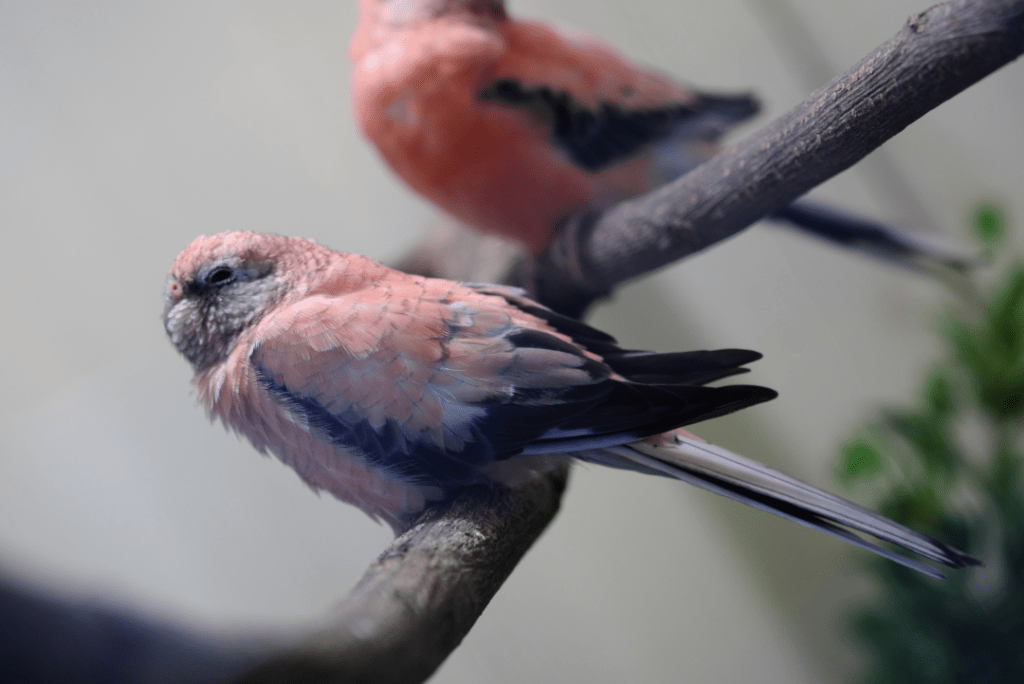
Habitat and geographic range
Found in the arid and semi-arid regions of central and western Australia, they inhabit grasslands, scrublands, and woodlands.
Size:
- Length: 18-23 cm
- Weight: 40-55 g
Average life expectancy
Bourke’s Parakeets can live 5-8 years in the wild, up to 15 years in captivity.
Tips for spotting and attracting Bourke's Parakeets
Look for them feeding on seeds, fruit, and insects in trees and on the ground. They can be attracted to gardens by providing native plants, bird feeders with seeds, and a birdbath for drinking and bathing.
Pink Robin (Petroica rodinogaster)
The Pink Robin is a small, captivating songbird native to Australia. Males have a striking deep pink chest and throat, with a dark gray head and wings, while females have a duller pinkish-gray chest.
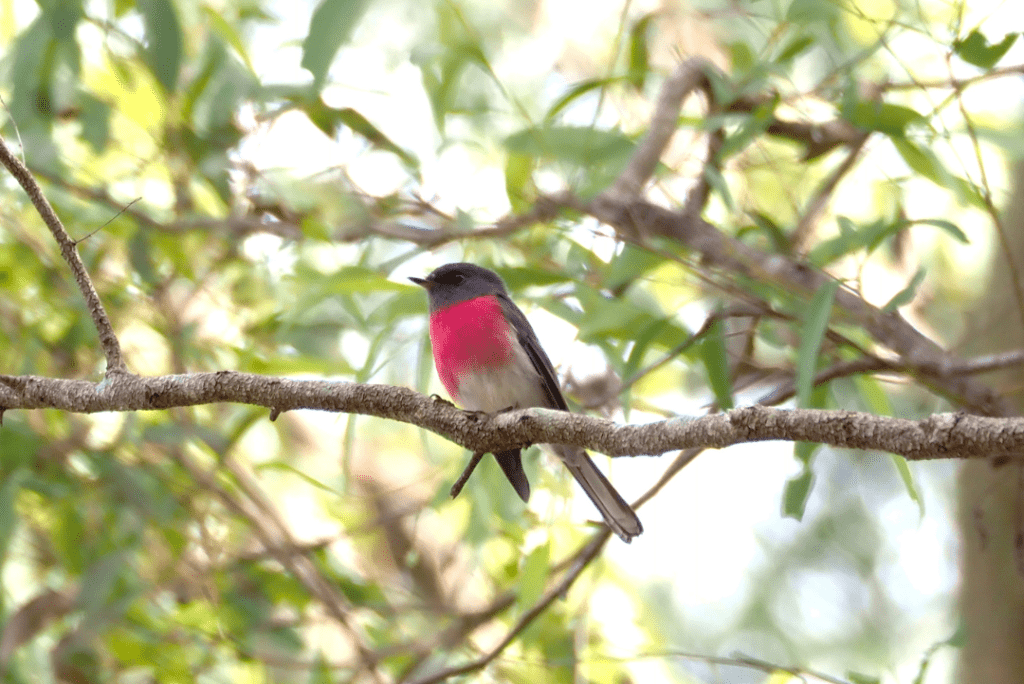
Habitat and geographic range
They inhabit dense, wet forests and rainforests in southeastern Australia and Tasmania.
Size:
- Length: 12-14 cm
- Weight: 10-12 g
Average life expectancy
Pink Robins live 5-7 years on average.
Tips for spotting and attracting Pink Robins
Visit their natural habitat during the breeding season (from September to January) and listen for their melodious songs. Look for them foraging in the understory or on the ground. Be patient, as these small birds can be elusive.
Pink-headed Fruit Dove (Ptilinopus porphyreus)
The Pink-headed Fruit Dove is a small, exquisite dove native to Indonesia. They have a vibrant pink head and chest, with a green body and dark blue wings. Males have a more vivid coloration than females.

Habitat and geographic range
They inhabit montane forests, rainforests, and fruit gardens in Sumatra, Java, and Bali in Indonesia.
Size:
- Length: 20-24 cm
- Weight: 100-120 g
Average life expectancy
Unknown
Tips for spotting and attracting Pink-headed Fruit Doves
To increase your chances of spotting Pink-headed Fruit Doves, visit their natural habitats in Sumatra, Java, and Bali during the breeding season (April to September). Focus on fruiting trees where they are likely to feed on fruits and berries.
African Pink Birds
African Spoonbill (Platalea alba)
The African Spoonbill is a wading bird characterized by its long, spatula-shaped bill, white plumage with a pinkish hue, and reddish-pink legs. They use their unique bill to sift through the water, capturing small aquatic animals.
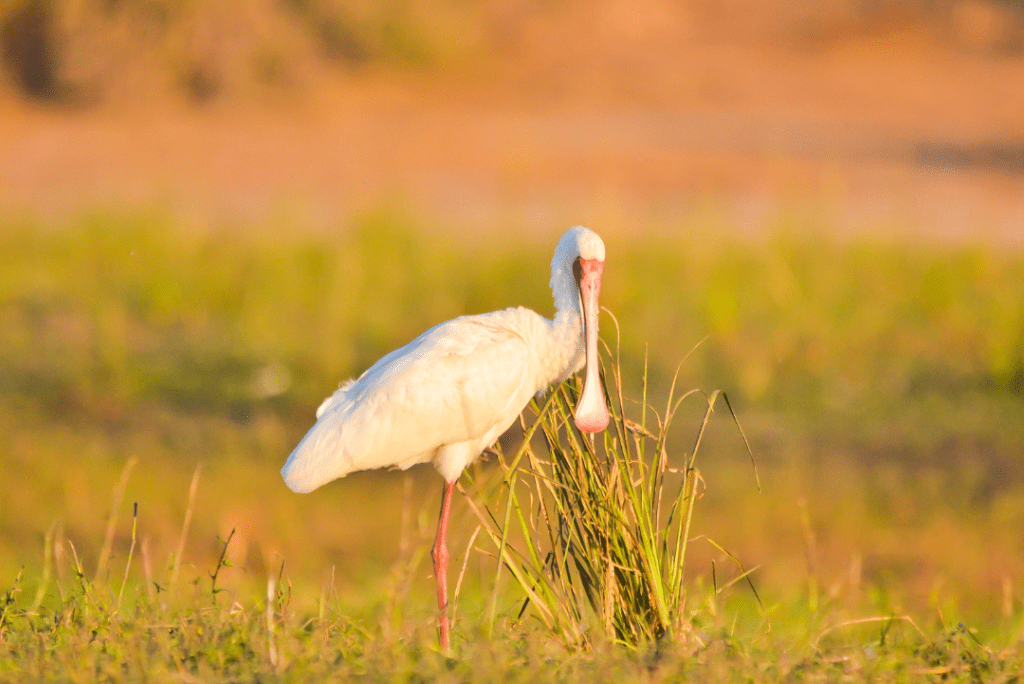
Habitat and geographic range
Found throughout sub-Saharan Africa, they inhabit wetlands, marshes, and shallow lakes.
Size:
- Length: 85-90 cm
- Weight: 1.2-1.5 kg
- Wingspan: 120-135 cm
Average life expectancy
African Spoonbills typically live 15-20 years.
Tips for spotting and attracting African Spoonbills
Look for them wading in shallow waters, sweeping their bills from side to side in search of food. Visit wetlands, marshes, and shallow lakes during the breeding season (from August to December) for the best chance of spotting them.
Southern Carmine Bee-eater (Merops nubicoides)
The Southern Carmine Bee-eater is a stunning, brightly colored bird with a predominantly carmine-pink body, a turquoise-blue forehead, and a black eye stripe. They are skilled aerial acrobats, catching insects, especially bees, in mid-flight.
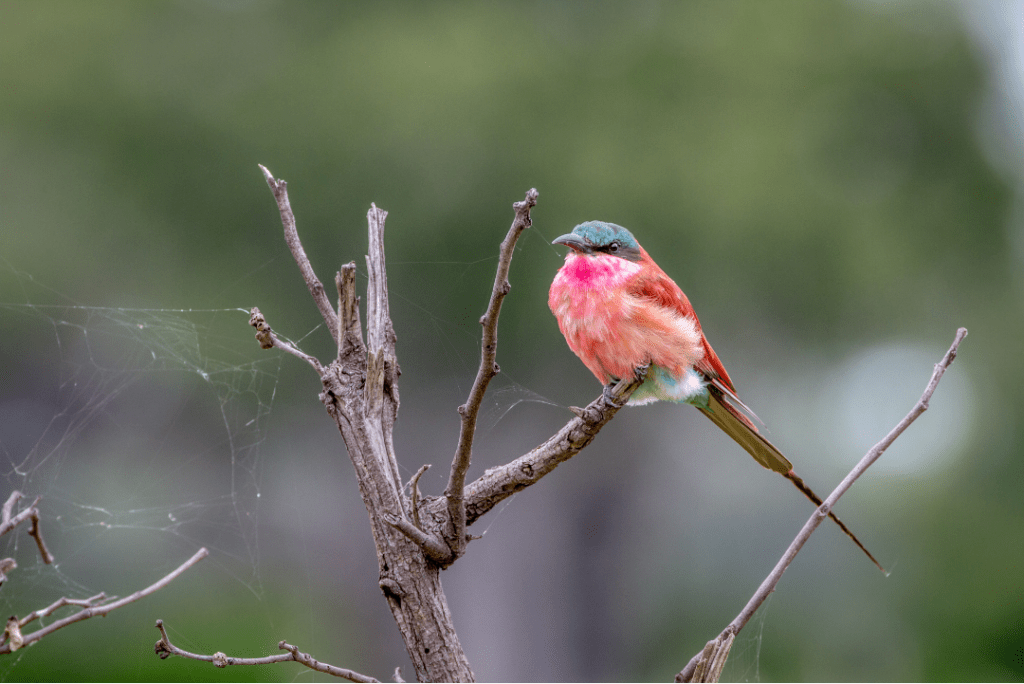
Habitat and geographic range
They inhabit open grasslands, savannas, and riverbanks in southern Africa.
Size:
- Length: 25-29 cm
- Weight: 35-45 g
- Wingspan: 40-45 cm
Average life expectancy
Southern Carmine Bee-eaters typically live 6-8 years.
Tips for spotting and attracting Southern Carmine Bee-eaters
Look for them perched on branches or in flight, as they catch insects in the air. Visit their natural habitat during the breeding season (from September to November) and listen for their distinctive calls.
Northern Carmine Bee-eater (Merops nubicus)
The Northern Carmine Bee-eater is similar in appearance to its southern counterpart, with a predominantly carmine-pink body, a turquoise-blue forehead, and a black eye stripe. They are also known for their aerial acrobatics and bee-catching skills.

Habitat and geographic range
Found in sub-Saharan Africa, they inhabit open grasslands, savannas, and riverbanks.
Size:
- Length: 25-29 cm
- Weight: 35-45 g
- Wingspan: 40-45 cm
Average life expectancy
Northern Carmine Bee-eaters typically live 6-8 years.
Tips for spotting and attracting Northern Carmine Bee-eaters
Look for them perched on branches or in flight, catching insects in the air. Visit their natural habitat during the breeding season (from August to November) and listen for their distinctive calls.
Conclusion
In this captivating journey through the world of pink birds, we’ve explored 23 beautiful species, each with its unique features and habitats. From the iconic Greater Flamingo to the elusive Pink Robin, these feathered beauties remind us of the incredible diversity of the avian world.
As we appreciate and marvel at these stunning birds, let’s not forget the importance of conservation efforts to protect their habitats and ensure their survival. By learning more about these birds and sharing our passion for birdwatching, we can contribute to their appreciation and protection for generations to come.
Happy birding!

James has always been an avid outdoorsman. Since a kid, he kept a journal of all the different birds and species he saw. Now he wants to share his passion with other birders with Happy Birding!

